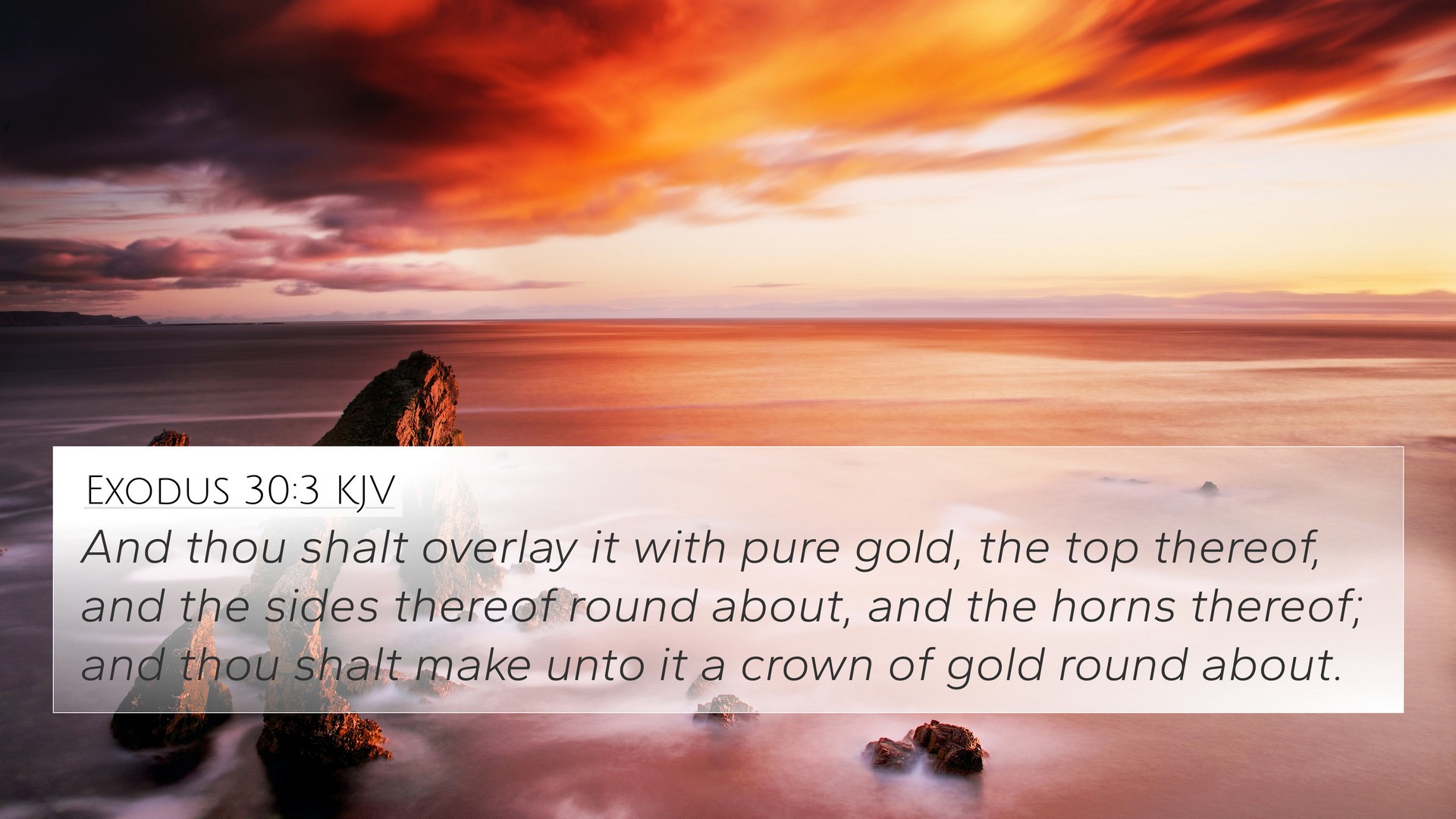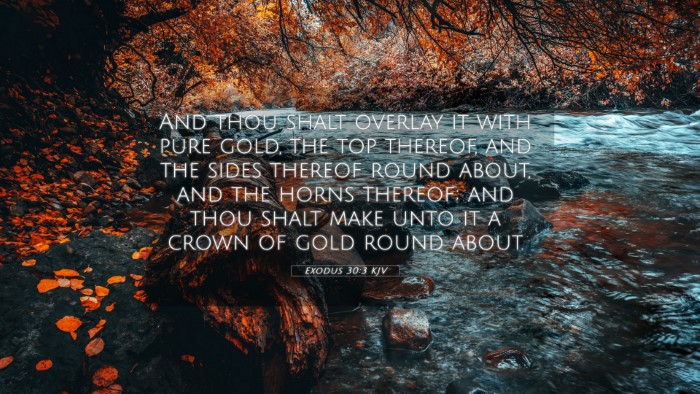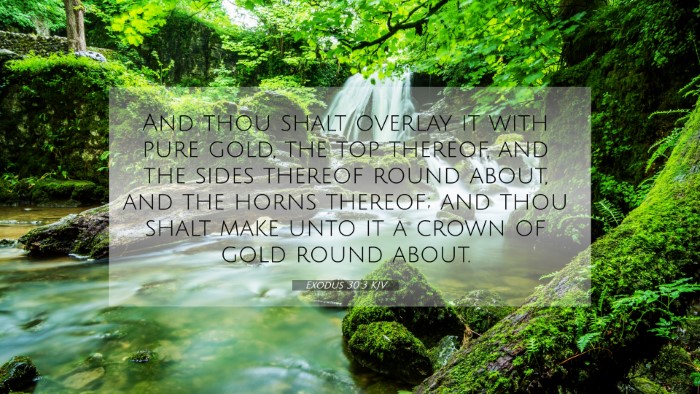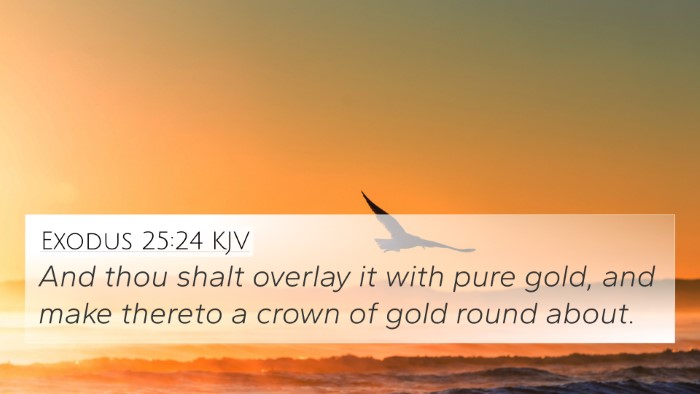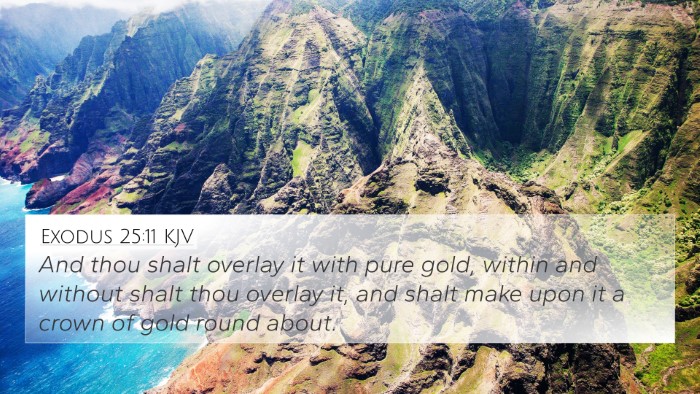Understanding Exodus 30:3
Exodus 30:3 states, "And you shall overlay its top, its sides all around, and its horns with pure gold; and you shall make for it a molding of gold all around." This verse is part of God's instructions for the construction of the altar of incense in the Tabernacle, which serves as a profound symbol of prayer and worship in the Old Testament.
Summary of Insights
Various public domain commentaries such as those by Matthew Henry, Albert Barnes, and Adam Clarke provide a comprehensive interpretation of this verse.
Matthew Henry's Commentary
Matthew Henry emphasizes the significance of the golden overlay, symbolizing purity and the divine nature of the worship that was to be brought before God. He highlights that gold represents deity and value, underscoring the importance of presenting our worship in the purest form to the Lord.
Albert Barnes' Notes
Albert Barnes provides insights into the construction details, noting that the altar was meant to be a central point for offering incense, a metaphor for the prayers of the saints ascending to God. He connects the physical act of enhancing the altar's beauty to the inward necessity for sincere and heartfelt worship.
Adam Clarke's Commentary
Adam Clarke delves into the materials used in the altar's construction. He points out how the use of gold indicates the altar's special role and its separation from ordinary things. Clarke suggests that every detail in the construction was intended to reflect God's holiness and the costly nature of our devotion.
Bible Verse Cross-References
This verse connects with several other scriptures that provide deeper insight into its meaning:
- Revelation 5:8: Portrays the altar of incense as symbolic of prayers being offered to God.
- 1 Peter 2:5: Suggests believers are to be living stones, offering spiritual sacrifices, paralleling the dedication of the separate altar.
- Hebrews 9:4: Mentions the altar of incense within the context of the Holy Place, linking to the significance of worship practices.
- Philippians 4:18: Refers to sacrificial offerings pleasing to God, echoing the theme of dedicated worship.
- James 5:16: Talks about the effective prayer of a righteous person, connecting to the purpose of the altar.
- Psalm 141:2: Describes prayers as incense before the Lord, reinforcing the symbolic interpretation of the altar's use.
- Isaiah 60:6: Illustrates how offerings, like those at the altar, were acknowledgement of God's glory and provision.
Importance of Linking Bible Scriptures
Cross-referencing biblical texts helps readers understand the interconnected nature of scripture. By exploring the links between Exodus 30:3 and other verses, individuals can gain insights into the overall themes of worship, holiness, and divine communication:
- Thematic Bible Verse Connections: Understanding how Exodus 30:3 ties to the overarching theme of worship in both the Old and New Testaments.
- Bible Verse Parallels: Drawing parallels between the Old Testament rituals and their fulfillment in the New Testament through Christ’s sacrifice.
- Identifying connections between Old and New Testament: Exploring how practices in the Old Testament are fulfilled in the New Covenant.
Tools for Bible Cross-Referencing
Engaging in a thorough study of biblical connections can be facilitated using various tools and resources:
- Bible Concordance: A powerful tool for finding specific words and their occurrences throughout scripture.
- Bible Cross-Reference Guide: Helps identify parallels and cross-references among verses effectively.
- Comprehensive Bible Cross-Reference Materials: Books and online resources that offer exhaustive studies on interrelated scriptures.
Conclusion
Exodus 30:3 serves not only as an instruction for the Israelites but also as a profound insight into the nature of worship. By engaging in comparative Bible verse analysis and cross-referencing biblical texts, believers can deepen their understanding of God's requirements and the beauty of worship that honors Him.
As you explore the connections and themes of this verse, consider how this foundational understanding of the altar reflects into personal worship practices today.
